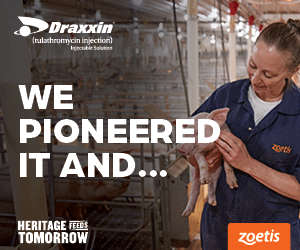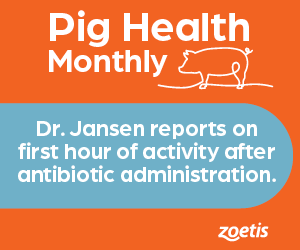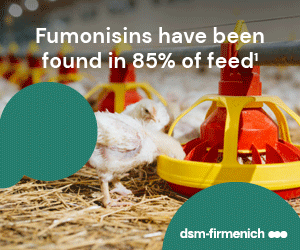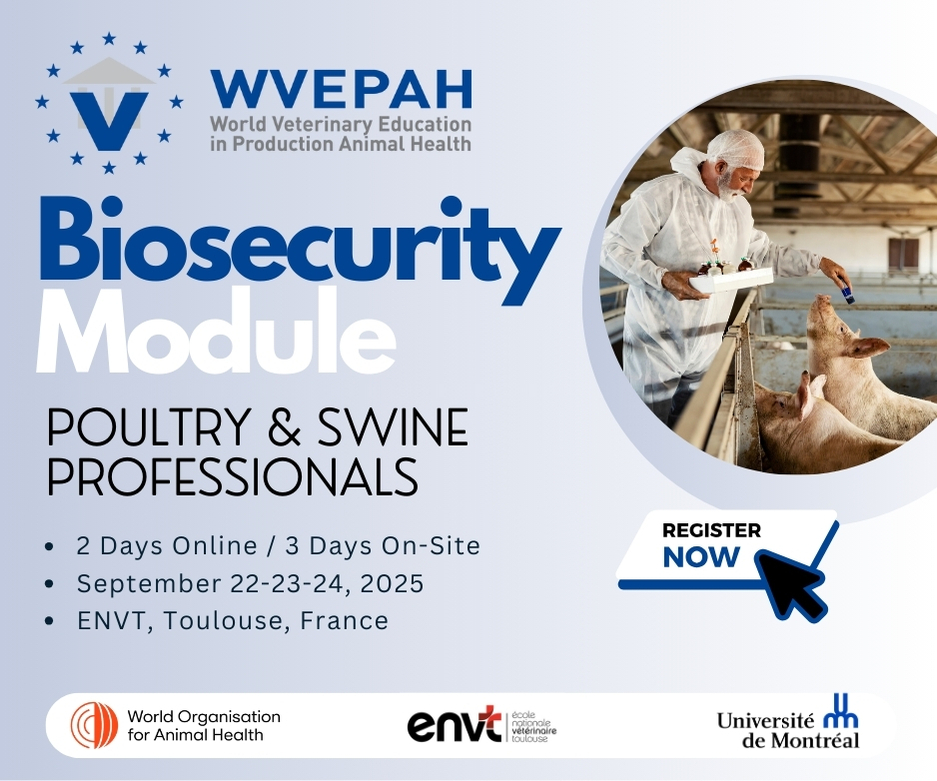



Using pig behaviour to optimize pen design
By Bernard Peet, Pork Industry Consultant, Lacombe, Canada. In these days of fully slatted pen floors, there is a tendency to think that pen shape and layout is less important than when part slatted and solid floors were more widely used. If pigs dung in the "wrong" place, it isn't really a problem in a fully slatted pen, whereas it may mean a lot of work scraping pens where the lying area has a solid floor.|
By Bernard Peet
 |
However, where pigs lie and dung within the pen is an indication of whether the pen design fulfils the pig's behavioural needs and this is influenced by pen shape, area, position of equipment, flooring type, bedding, temperature and air speed. If all of these things are correct, pigs will rest and sleep in a defined lying area and dung consistently in the same space, although extremely high temperatures may affect this pattern. In the wild, pigs make a sleeping area or den out of leaves, branches and grass which is warm and draft-free. They leave the den to forage for food, to find water and to dung or urinate. The three functions of resting, feeding and dunging take place in totally different areas. If we can meet these requirements in the pen design within intensive systems and fulfil the pig's behavioural needs, this will lead to improved performance and fewer behavioural problems such as tail biting.
In my previous WHJ article, I defined the space requirements of the pig. What we do with that space is the most important aspect of pen design. Pen shape is the first consideration - generally the ratio of length to width should be between 1.5:1 and 2.5:1. This ratio is much more important in smaller pens, whereas in a large nursery or finisher pen it could be higher. However, as a rule, long narrow pens are undesirable. A rectangular shape differentiates one end into a lying area and the other into a dunging area. In a part slatted pen, the lying area is further differentiated by being solid, which at most temperatures will be more attractive to the pig. A step between lying and dunging areas also helps to define the boundary.
The lying area should provide an adequate area of undisturbed space, which means that pigs should not have to walk through their sleeping pen-mates to access other areas more than is necessary. Therefore feeders should be positioned between the lying and dunging areas. Figure 1 shows the ideal layout and the correct feeder position. Often feeders are placed in the lying area, at the end of the pen, for ease of access, which greatly increases disturbance of resting pigs. The arrows on the diagram show the pig flow, from resting to feeding, to drinking and then to dunging, that will minimize disturbance.
 Pigs will dung in the corners of the pen because they want to carry out that function in a quiet well-protected place, as in the wild. Drinkers should therefore be positioned away from those corners, as shown on the diagram, either at the back or the side of the dunging area.
Pigs will dung in the corners of the pen because they want to carry out that function in a quiet well-protected place, as in the wild. Drinkers should therefore be positioned away from those corners, as shown on the diagram, either at the back or the side of the dunging area.
The ventilation system is also of major importance in achieving both comfortable conditions in the lying area and differentiation of the dunging area. Incoming air should be directed towards the dunging area so that it is slightly cooler and the air speed is higher making it less desirable as a place to lie. Systems which provide a linear air-flow pattern all down the barn will give consistent air-flow patterns from pen to pen.
I have shown the "ideal" pen as partly slatted because the principles are easier to demonstrate, but they still apply where fully slatted floors are used. Whatever type of floor is used, getting pen shape and layout wrong can be costly. In most cases this is a loss of performance which may not even be noticed. For example, incorrect feeder positioning leading to increased disturbance of resting pigs may lead to poorer feed efficiency or slower growth. A long, narrow pen shape may mean that the less dominant pigs spend less time feeding because getting to the feeders means climbing over and disturbing their more dominant pen-mates, with obvious consequences. In this case reduced growth rate and increased variability of pig weights will be observed.
If pen design is badly wrong it will lead to significant loss of performance and behavioural abnormalities such as tail biting. A client in Britain had severe tail biting problems in long grower pens with circular feeders part way down the lying area. When pigs were feeding, they effectively stopped other pigs moving up or down the pen, creating stress. This was exacerbated by drafts due to incorrectly adjusted air inlets. Correcting the ventilation and altering the pen layout solved the problem. Anything in a pen's design that stops the pig carrying out its behavioural requirements of sleeping, feeding, drinking and dunging, will create stress and reduce performance, even when the overall space allowance is adequate. For example, if pigs are forced to lie in an "undesirable" area, the stress may trigger tail biting. Because these pigs are the less dominant ones in the pen, that's why they are often observed to be doing the biting. Common examples of this are where some pigs are forced to lie in a drafty area or in an "active" area close to a feeder or drinker.
 Finally, some observations on the trend towards bigger pens and larger groups. Much of the trial work that has compared conventional, small groups with large groups has involved creating the larger pens by removing the pen divisions between two or more smaller pens. This changes the pen layout dramatically, sometimes to the point that pigs are totally confused because equipment positioning and ventilation becomes incorrect for the pen shape. Consequently, I believe that the comparisons and conclusions in such work are often misleading. If the bigger pens were designed according to the principles outlined above, performance of pigs in large groups would be better. Indeed, having more area in the pen allows a much clearer differentiation of lying, feeding, drinking and dunging areas. This is shown in the photo of the nursery pen in a new barn, specifically designed to achieve this.
Finally, some observations on the trend towards bigger pens and larger groups. Much of the trial work that has compared conventional, small groups with large groups has involved creating the larger pens by removing the pen divisions between two or more smaller pens. This changes the pen layout dramatically, sometimes to the point that pigs are totally confused because equipment positioning and ventilation becomes incorrect for the pen shape. Consequently, I believe that the comparisons and conclusions in such work are often misleading. If the bigger pens were designed according to the principles outlined above, performance of pigs in large groups would be better. Indeed, having more area in the pen allows a much clearer differentiation of lying, feeding, drinking and dunging areas. This is shown in the photo of the nursery pen in a new barn, specifically designed to achieve this.
In my experience troubleshooting in various parts of the world, incorrect pen design is a major source of lost margin. Attention to meeting the pig's behavioural needs through appropriate layouts, equipment positioning and ventilation will optimize performance and reduce the likelihood of abnormal behaviour.
In my previous WHJ article, I defined the space requirements of the pig. What we do with that space is the most important aspect of pen design. Pen shape is the first consideration - generally the ratio of length to width should be between 1.5:1 and 2.5:1. This ratio is much more important in smaller pens, whereas in a large nursery or finisher pen it could be higher. However, as a rule, long narrow pens are undesirable. A rectangular shape differentiates one end into a lying area and the other into a dunging area. In a part slatted pen, the lying area is further differentiated by being solid, which at most temperatures will be more attractive to the pig. A step between lying and dunging areas also helps to define the boundary.
The lying area should provide an adequate area of undisturbed space, which means that pigs should not have to walk through their sleeping pen-mates to access other areas more than is necessary. Therefore feeders should be positioned between the lying and dunging areas. Figure 1 shows the ideal layout and the correct feeder position. Often feeders are placed in the lying area, at the end of the pen, for ease of access, which greatly increases disturbance of resting pigs. The arrows on the diagram show the pig flow, from resting to feeding, to drinking and then to dunging, that will minimize disturbance.
 Pigs will dung in the corners of the pen because they want to carry out that function in a quiet well-protected place, as in the wild. Drinkers should therefore be positioned away from those corners, as shown on the diagram, either at the back or the side of the dunging area.
Pigs will dung in the corners of the pen because they want to carry out that function in a quiet well-protected place, as in the wild. Drinkers should therefore be positioned away from those corners, as shown on the diagram, either at the back or the side of the dunging area.
The ventilation system is also of major importance in achieving both comfortable conditions in the lying area and differentiation of the dunging area. Incoming air should be directed towards the dunging area so that it is slightly cooler and the air speed is higher making it less desirable as a place to lie. Systems which provide a linear air-flow pattern all down the barn will give consistent air-flow patterns from pen to pen.
I have shown the "ideal" pen as partly slatted because the principles are easier to demonstrate, but they still apply where fully slatted floors are used. Whatever type of floor is used, getting pen shape and layout wrong can be costly. In most cases this is a loss of performance which may not even be noticed. For example, incorrect feeder positioning leading to increased disturbance of resting pigs may lead to poorer feed efficiency or slower growth. A long, narrow pen shape may mean that the less dominant pigs spend less time feeding because getting to the feeders means climbing over and disturbing their more dominant pen-mates, with obvious consequences. In this case reduced growth rate and increased variability of pig weights will be observed.
If pen design is badly wrong it will lead to significant loss of performance and behavioural abnormalities such as tail biting. A client in Britain had severe tail biting problems in long grower pens with circular feeders part way down the lying area. When pigs were feeding, they effectively stopped other pigs moving up or down the pen, creating stress. This was exacerbated by drafts due to incorrectly adjusted air inlets. Correcting the ventilation and altering the pen layout solved the problem. Anything in a pen's design that stops the pig carrying out its behavioural requirements of sleeping, feeding, drinking and dunging, will create stress and reduce performance, even when the overall space allowance is adequate. For example, if pigs are forced to lie in an "undesirable" area, the stress may trigger tail biting. Because these pigs are the less dominant ones in the pen, that's why they are often observed to be doing the biting. Common examples of this are where some pigs are forced to lie in a drafty area or in an "active" area close to a feeder or drinker.
 Finally, some observations on the trend towards bigger pens and larger groups. Much of the trial work that has compared conventional, small groups with large groups has involved creating the larger pens by removing the pen divisions between two or more smaller pens. This changes the pen layout dramatically, sometimes to the point that pigs are totally confused because equipment positioning and ventilation becomes incorrect for the pen shape. Consequently, I believe that the comparisons and conclusions in such work are often misleading. If the bigger pens were designed according to the principles outlined above, performance of pigs in large groups would be better. Indeed, having more area in the pen allows a much clearer differentiation of lying, feeding, drinking and dunging areas. This is shown in the photo of the nursery pen in a new barn, specifically designed to achieve this.
Finally, some observations on the trend towards bigger pens and larger groups. Much of the trial work that has compared conventional, small groups with large groups has involved creating the larger pens by removing the pen divisions between two or more smaller pens. This changes the pen layout dramatically, sometimes to the point that pigs are totally confused because equipment positioning and ventilation becomes incorrect for the pen shape. Consequently, I believe that the comparisons and conclusions in such work are often misleading. If the bigger pens were designed according to the principles outlined above, performance of pigs in large groups would be better. Indeed, having more area in the pen allows a much clearer differentiation of lying, feeding, drinking and dunging areas. This is shown in the photo of the nursery pen in a new barn, specifically designed to achieve this.
In my experience troubleshooting in various parts of the world, incorrect pen design is a major source of lost margin. Attention to meeting the pig's behavioural needs through appropriate layouts, equipment positioning and ventilation will optimize performance and reduce the likelihood of abnormal behaviour.
|


















